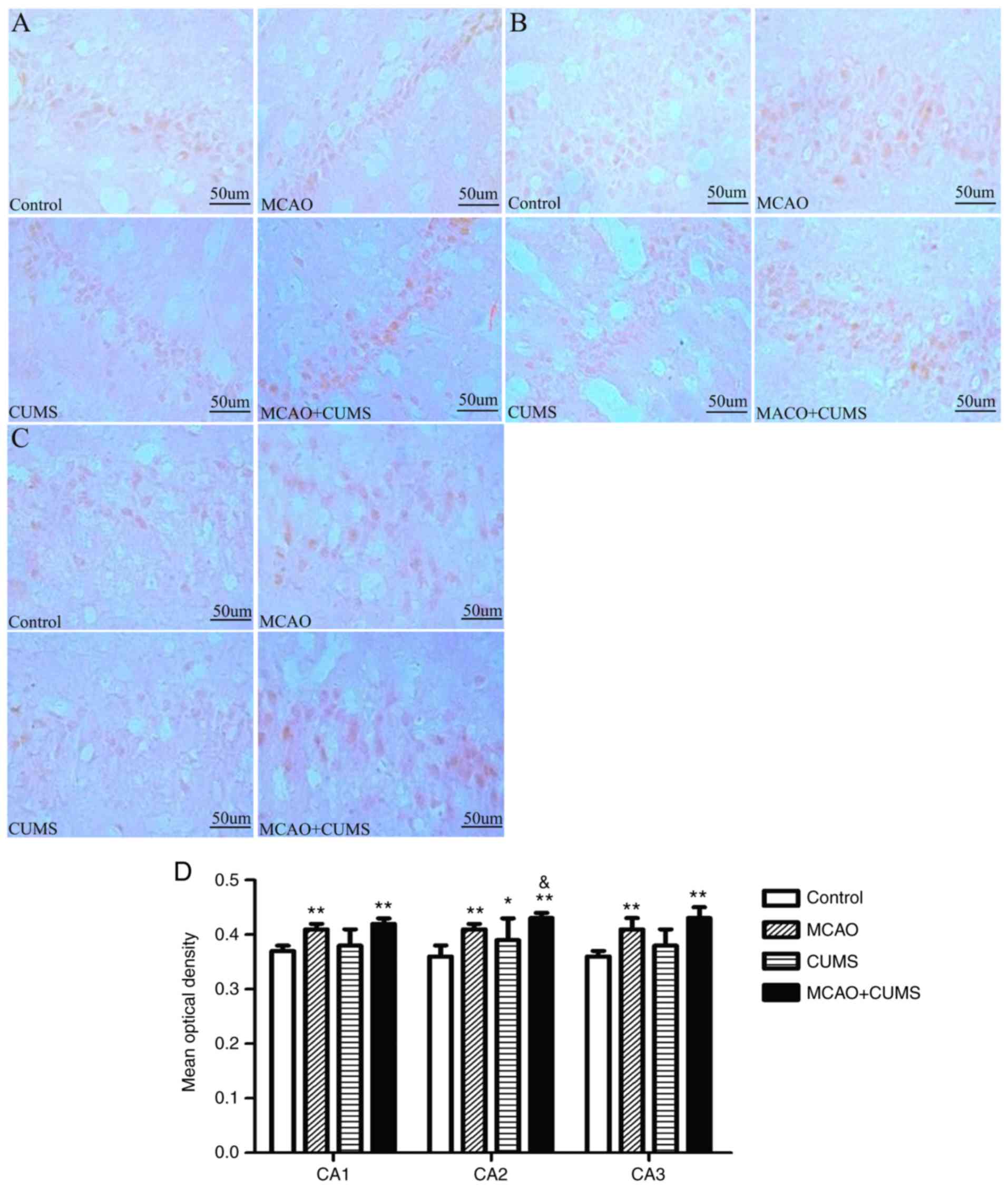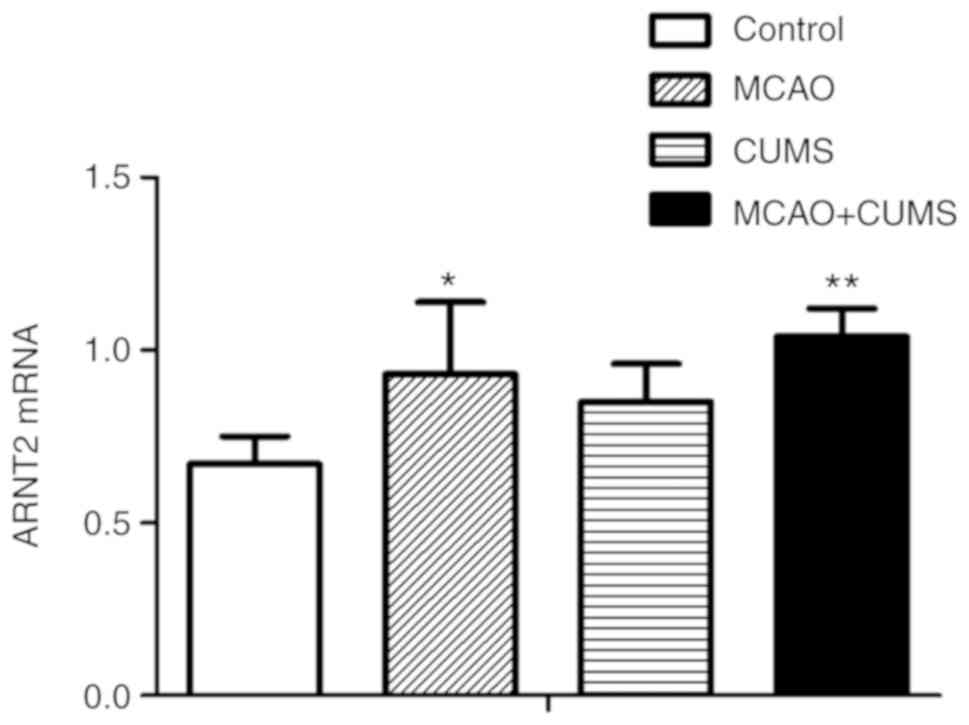|
1
|
Kronenberg G, Gertz K, Heinz A and Endres
M: Of mice and men: Modelling post-stroke depression
experimentally. Br J Pharmacol. 171:4673–4689. 2014.PubMed/NCBI View Article : Google Scholar
|
|
2
|
Robinson RG and Jorge RE: Post stroke
depression: A review. Am J Psychiatry. 173:221–231. 2016.PubMed/NCBI View Article : Google Scholar
|
|
3
|
Nabavi SF, Habtemariam S, Di Lorenzo A,
Sureda A, Khanjani S, Nabavi SM and Daglia M: Post-stroke
depression modulation and in vivo antioxidant activity of gallic
acid and its synthetic derivatives in a murine model system.
Nutrients. 8(E248)2016.PubMed/NCBI View Article : Google Scholar
|
|
4
|
Mozaffarian D, Benjamin EJ, Go AS, Arnett
DK, Blaha MJ, Cushman M, de Ferranti S, Després JP, Fullerton HJ,
Howard VJ, et al: Heart disease and stroke statistics-2015 update:
A report from the American Heart Association. Circulation.
131:e29–e322. 2015.PubMed/NCBI View Article : Google Scholar
|
|
5
|
Wang S, Sun H, Liu S, Wang T, Guan J and
Jia J: Role of hypothalamic cannabinoid receptors in post-stroke
depression in rats. Brain Res Bull. 121:91–97. 2016.PubMed/NCBI View Article : Google Scholar
|
|
6
|
Swartz RH, Bayley M, Lanctôt KL, Murray
BJ, Cayley ML, Lien K, Sicard MN, Thorpe KE, Dowlatshahi D, Mandzia
JL, et al: Post-stroke depression, obstructive sleep apnea, and
cognitive impairment: Rationale for, and barriers to, routine
screening. Int J Stroke. 11:509–518. 2016.PubMed/NCBI View Article : Google Scholar
|
|
7
|
Nabavi SF, Dean OM, Turner A, Sureda A,
Daglia M and Nabavi SM: Oxidative stress and post stroke
depression: Possible therapeutic role of polyphenols? Curr Med
Chem. 22:343–351. 2015.PubMed/NCBI View Article : Google Scholar
|
|
8
|
Loubinoux I, Kronenberg G, Endres M,
Schumann-Bard P, Freret T, Filipkowski RK, Kaczmarek L and
Popa-Wagner A: Post-stroke depression: Mechanisms, translation and
therapy. J Cell Mol Med. 16:1961–1969. 2012.PubMed/NCBI View Article : Google Scholar
|
|
9
|
Nabavi SF, Turner A, Dean O, Sureda A and
Mohammad S: Post stroke depression therapy: Where are we now? Curr
Neurovasc Res. 11:279–289. 2014.PubMed/NCBI View Article : Google Scholar
|
|
10
|
Drutel G, Héron A, Kathmann M, Gros C,
Macé S, Plotkine M, Schwartz JC and Arrang JM: ARNT2 a
transcription factor for brain neuron survival? Eur J Neurosci.
11:1545–1553. 1999.PubMed/NCBI View Article : Google Scholar
|
|
11
|
Dougherty EJ and Pollenz RS: Analysis of
Ah receptor-ARNT and Ah receptor-ARNT2 complexes in vitro and in
cell culture. Toxicol Sci. 103:191–206. 2008.PubMed/NCBI View Article : Google Scholar
|
|
12
|
Rajashekaran P, Pai K, Thunga R and
Unnikrishnan B: Post-stroke depression and lesion location: A
hospital based cross-sectional study. Indian J Psychiatry.
55:343–348. 2013.PubMed/NCBI View Article : Google Scholar
|
|
13
|
Keith B, Adelman DM and Simon MC: Targeted
mutation of the murine arylhydrocarbon receptor nuclear
translocator 2 (Arnt2) gene reveals partial redundancy with Arnt.
Proc Natl Acad Sci USA. 98:6692–6697. 2001.PubMed/NCBI View Article : Google Scholar
|
|
14
|
Corcoran SE and O'Neill LA: HIF1α and
metabolic reprogramming in inflammation. J Clin Invest.
126:3699–3707. 2016.PubMed/NCBI View
Article : Google Scholar
|
|
15
|
Maltepe E, Keith B, Arsham AM, Brorson JR
and Simon MC: The role of ARNT2 in tumor angiogenesis and the
neural response to hypoxia. Biochem Biophys Res Commun.
273:231–238. 2000.PubMed/NCBI View Article : Google Scholar
|
|
16
|
Dela Cruz JA, Schmidt-Kastner R, Stevens
JA, Steinbusch HW and Rutten BP: Differential distribution of
hypoxia-inducible factor 1-beta (ARNT or ARNT2) in mouse substantia
nigra and ventral tegmental area. J Chem Neuroanat. 61-62:64–71.
2014.PubMed/NCBI View Article : Google Scholar
|
|
17
|
den Heijer T, Tiemeier H, Luijendijk HJ,
van der Lijn F, Koudstaal PJ, Hofman A and Breteler MM: A study of
the bidirectional association between hippocampal volume on
magnetic resonance imaging and depression in the elderly. Biol
Psychiatry. 70:191–197. 2011.PubMed/NCBI View Article : Google Scholar
|
|
18
|
Kempton MJ, Salvador Z, Munafò MR, Geddes
JR, Simmons A, Frangou S and Williams SC: Structural neuroimaging
studies in major depressive disorder. Meta-analysis and comparison
with bipolar disorder. Arch Gen Psychiatry. 68:675–690.
2011.PubMed/NCBI View Article : Google Scholar
|
|
19
|
Erickson KI, Prakash RS, Voss MW, Chaddock
L, Heo S, McLaren M, Pence BD, Martin SA, Vieira VJ, Woods JA, et
al: Brain-derived neurotrophic factor is associated with
age-related decline in hippocampal volume. J Neurosci.
30:5368–5375. 2010.PubMed/NCBI View Article : Google Scholar
|
|
20
|
Li G, Peskind ER, Millard SP, Chi P, Sokal
I, Yu CE, Bekris LM, Raskind MA, Galasko DR and Montine TJ:
Cerebrospinal fluid concentration of brain-derived neurotrophic
factor and cognitive function in non-demented subjects. PLoS One.
4(e5424)2009.PubMed/NCBI View Article : Google Scholar
|
|
21
|
Zhang ZH, Wu LN, Song JG and Li WQ:
Correlations between cognitive impairment and brain-derived
neurotrophic factor expression in the hippocampus of post-stroke
depression rats. Mol Med Rep. 6:889–893. 2012. View Article : Google Scholar
|
|
22
|
Zhao DA, Bi LY, Huang Q, Zhang FM and Han
ZM: Isoflurane provides neuroprotection in neonatal hypoxic
ischemic brain injury by suppressing apoptosis. Braz J Anesthesiol.
66:613–621. 2016.PubMed/NCBI View Article : Google Scholar
|
|
23
|
Xu Y, Tian Y, Tian Y, Li X and Zhao P:
Autophagy activation involved in hypoxic-ischemic brain injury
induces cognitive and memory impairment in neonatal rats. J
Neurochem. 139:795–805. 2016.PubMed/NCBI View Article : Google Scholar
|
|
24
|
Valen E, Pascarella G, Chalk A, Maeda N,
Kojima M, Kawazu C, Murata M, Nishiyori H, Lazarevic D, Motti D, et
al: Genome-wide detection and analysis of hippocampus core
promoters using DeepCAGE. Genome Res. 19:255–265. 2008.PubMed/NCBI View Article : Google Scholar
|
|
25
|
Zhang Z, Fei P, Mu J, Wang H, Li W and
Song J: Decreased expression of neuronal Per-Arnt-Sim domain
protein 4 gene in the hippocampus of a post-stroke depression rat
model. Exp Ther Med. 7:1045–1049. 2014.PubMed/NCBI View Article : Google Scholar
|
|
26
|
Willner P: Chronic mild stress (CMS)
revisited: Consistency and behavioural-neurobiological concordance
in the effects of CMS. Neuropsychobiology. 52:90–110.
2005.PubMed/NCBI View Article : Google Scholar
|
|
27
|
Chen Q, Ren L, Min S, Hao X, Chen H and
Deng J: Changes in synaptic plasticity are associated with
electroconvulsive shock-induced learning and memory impairment in
rats with depression-like behavior. Neuropsychiatr Dis Treat.
14:1737–1746. 2018.PubMed/NCBI View Article : Google Scholar
|
|
28
|
Ren L, Hao X, Min S, Deng J, Chen Q, Chen
H and Liu D: Anesthetics alleviate learning and memory impairment
induced by electroconvulsive shock by regulation of NMDA
receptor-mediated metaplasticity in depressive rats. Neurobiol
Learn Mem. 155:65–77. 2018.PubMed/NCBI View Article : Google Scholar
|
|
29
|
Araujo SM, Poetini MR, Bortolotto VC, de
Freitas Couto S, Pinheiro FC, Meichtry LB, de Almeida FP, Santos
Musachio EA, de Paula MT and Prigol M: Chronic unpredictable mild
stress-induced depressive-like behavior and dysregulation of brain
levels of biogenic amines in Drosophila melanogaster. Behav Brain
Res. 351:104–113. 2018.PubMed/NCBI View Article : Google Scholar
|
|
30
|
Shao QY, You F, Zhang YH, Hu LL, Liu WJ,
Liu Y, Li J, Wang SD and Song MF: CSF miR-16 expression and its
association with miR-16 and serotonin transporter in the raphe of a
rat model of depression. J Affect Disord. 238:609–614.
2018.PubMed/NCBI View Article : Google Scholar
|
|
31
|
Mandl M and Depping R: Hypoxia-inducible
aryl hydrocarbon receptor nuclear translocator (ARNT)(HIF-1β): Is
it a rare exception? Mol Med. 20:215–220. 2014.PubMed/NCBI View Article : Google Scholar
|
|
32
|
Mandl M, Lieberum MK and Depping R: A
HIF-1α-driven feed-forward loop augments HIF signalling in Hep3B
cells by upregulation of ARNT. Cell Death Dis.
7(e2284)2016.PubMed/NCBI View Article : Google Scholar
|
|
33
|
Kimura Y, Kasamatsu A, Nakashima D,
Yamatoji M, Minakawa Y, Koike K, Fushimi K, Higo M, Endo-Sakamoto
Y, Shiiba M, et al: ARNT2 regulates tumoral growth in oral squamous
cell carcinoma. J Cancer. 7:702–710. 2016.PubMed/NCBI View Article : Google Scholar
|
|
34
|
Arteaga O, Álvarez A, Revuelta M,
Santaolalla F, Urtasun A and Hilario E: Role of antioxidants in
neonatal hypoxic-ischemic brain injury: New therapeutic approaches.
Int J Mol Sci. 18(E265)2017.PubMed/NCBI View Article : Google Scholar
|
|
35
|
Kim YR, Kim HN, Pak ME, Ahn SM, Hong KH,
Shin HK and Choi BT: Studies on the animal model of post-stroke
depression and application of antipsychotic aripiprazole. Behav
Brain Res. 287:294–303. 2015.PubMed/NCBI View Article : Google Scholar
|
|
36
|
Kajta M, Wnuk A, Rzemieniec J, Litwa E,
Lason W, Zelek-Molik A, Nalepa I, Rogóż Z, Grochowalski A and
Wojtowicz AK: Depressive-like effect of prenatal exposure to DDT
involves global DNA hypomethylation and impairment of GPER1/ESR1
protein levels but not ESR2 and AHR/ARNT signaling. J Steroid
Biochem Mol Biol. 171:94–109. 2017.PubMed/NCBI View Article : Google Scholar
|
















